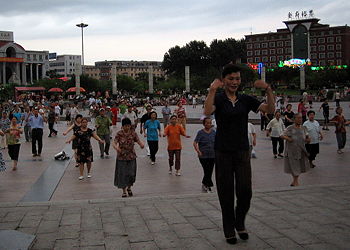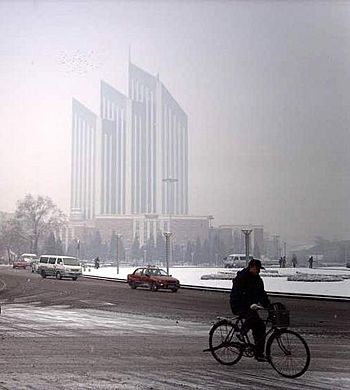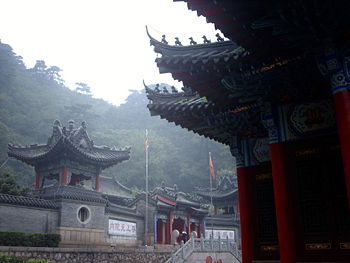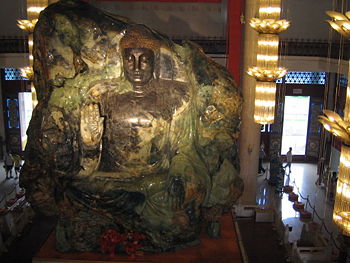Anshan
Ānshān (鞍山) is the third largest prefecture level city in Liaoning province of China. Situated in the central area of the province, it is about 92km south of Shenyang, the province's capital. Anshan is on the boundary between the Mountains of Eastern Liaoning and the plains of West. The area contains the famous Qianshan park. The city's name is derived form the shape of a nearby mountain (in Chinese shān 山) that resembles the shape of a horse's saddle (Ān 鞍). Anshan is home to the Angang Iron and Steel company, one of the largest steel producers in China.
History
Population

Renmin Park may be small, but it is popular. Large crowds of people gather there every evening for meet and take part in activities such as Taichi, Ballroom and Line Dancing, Exercizing, playing music, flying kites and more. The woman is leading this group of men and woman in a line dance.
Tourist attractions
In recent years, Anshan has been trying to through off it's image as a heavy industrial town along with the dirt and pollution that goes with such industry. It has remodeled it's self as a tourist destination.
Foremost among the attractions in Anshan is Qianshan Park which is about 12km by road, to the south east of the city. Qianshan literally means, 'Thousand Mountains'. The name is actually and abbreviation of 'Thousand lotus flower mountains'. The peaks were said to resemble the petals of the lotus flower which had been dropped to earth by a goddess. The area is filled with both Buddhist and Taoist temples, monasteries and nunneries. It is one of few locations where both religions are found sharing the same site.
Motor cars are not allowed within the park. Tourists must either walk or hire one of the electric taxi's. Many foot paths climb steeply up the hillsides through thick forest. These foot paths lead past, Steele, honoring the dead, small shrines and temples. For those who are less fit, three cable car routes can convey you up the hill sides. However, none of the cable cars will take you the whole way, leaving you some climbing to do by yourself. One mountain in the park is shaped in such a way that it resembles a Matria Buddha. It is claimed to be the largest naturally occurring image of Matria Buddha in the world. Several temples have been built on the peaks of the overlooking hills. Near the Matria Buddha is a large net enclosed area which contains an bird park.
Another major tourist location is Anshan's 219 park. The name of the park commemorates the liberation of Anshan by the People's Liberation Army on the 19th of February 1948. The park contains the Dongshan (East Mountain) scenic area as well as numerous lakes. Of particular note is the Jade Buddha temple (Yufo yuan). This large Buddhist temple complex houses the worlds large statue of Buddha that is made of Jade. It is a single piece of jade stone measuring 5.88 metres in width, 4.10 metres front to back and 7.85 metres high. The jade stone weighs 260.76 tons. The front of the stone has been carved with an image of Gautama Buddha. On the back of the stone Avalokitesvara Buddha has been carved.
Anshan contains naturally hot spring water spas. There are four spas/hotels in Anshan. Visitors may shower and bathe in the spring water. At Tanganxi Spa, once frequented by the Qin Emperors of China, visitors may have mud treatment where they are buried in hot volcanic sand, which has been infused with the spring water. The geothermal energy is also used to provide hot steam and water for winter heating throughout the area.
Transportation
Anshan has no public airport and no river or sea port so the only routes in or out are by land. The nearest airport is Shenyang Taoxian International Airport (SHE), about 90km to the north. The city is beside the Shanda highway (沈大高速公路) which runs between Shenyang and Dalian (the two larger cities of Liaoning province). This is a privately funded eight-lane tolled highway and was the first road of its kind in China. Anshan is also connected to the Chinese rail network with rail routes to Beijing, Dalian, and to the north-eastern provinces of Jilin and Hēilóngjiāng as well as to eastern Inner Mongolia and Russia. Long-distance coaches run to all the main cities of the province as well as to Beijing.
Local transportation is primarily by bus or taxi. Anshan used to have a single tram line along Zhonghua Avenue but this has been closed and the tracks removed. Due to the flat topography of the city centre, bicycles are popular. Almost all roads have a wide cycle lane on each side. Often this lane is further protected by a traffic island that separates the bikes from larger motor vehicles.


